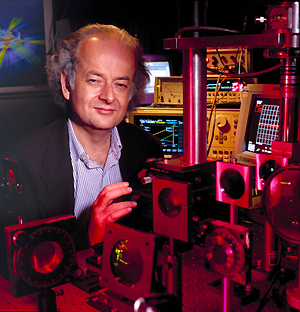Dr. Federico Capasso
Federico Capasso, Ph.D., Hon DEng was one of the inventors of the quantum cascade laser during his work at Bell Laboratories. He is currently on the faculty of Harvard University.
Federico received the doctor of Physics degree, summa cum laude, from the University of Rome, Italy, in 1973 and after doing research in fiber optics at Fondazione Bordoni in Rome, joined Bell Labs in 1976. In 1984 he was made a Distinguished Member of Technical Staff and in 1997 a Bell Labs Fellow.
In addition to his research activity, he has held several management positions at Bell Labs including Head of the Quantum Phenomena and Device Research Department and the Semiconductor Physics Research Department (1987–2000) and Vice President of Physical Research (2000–2002). He joined Harvard on January 1, 2003.
He is internationally known for his pioneering research on bandstructure engineering of artificially structured semiconductors and devices, which has opened up new directions in materials research, mesoscopic physics, photonics, electronics, and nanotechnology. He and his collaborators invented and developed the quantum cascade laser, a fundamentally new light source, which is now commercial and has potentially wide ranging applications to trace gas analysis and chemical sensing (atmospheric chemistry, combustion diagnostics, pollution monitoring, industrial process control, medical diagnostics, homeland security) and telecommunications.
His current research in quantum electronics deals with the design of new light sources based on giant optical nonlinearities in quantum wells such as Raman injection lasers, inversionless injection lasers and widely tunable sources of TeraHertz radiation based on difference frequency generation and Raman lasers. He has also carried out research on quantum chaos in deformed microlasers which led he and his collaborators to invent microlasers operating on bow-tie modes. More recently his research has expanded to high-precision measurements of Casimir forces using MEMS (MicroElectroMechanicalSystems) and other quantum electrodynamical effects such as the torque between birefringent materials due to vacuum fluctuations.
His honors include membership in the National Academy of Sciences, the National Academy of Engineering, the American Academy of Arts and Sciences, The European Academy of Sciences and honorary membership in the Franklin Institute.
In 2005 he received, jointly with Nobel Laureate Frank Wilczek (MIT) and Anton Zeilinger (University of Vienna), the prestigious King Faisal International Prize for Science for his research on quantum cascade lasers. The citation called him “one the most creative and influential physicists in the world”.
On behalf of the American Physical Society, he was awarded the 2004 Arthur L. Schawlow Prize in Laser Science, endowed by the NEC Corporation, for “seminal contributions to the invention and demonstration of the quantum cascade laser and the elucidation of its physics, which bridges quantum electronics, solid-state physics, and materials science.”
In addition, the IEEE (Institute of Electrical and Electronics Engineers), the world’s largest technical professional organization, named Federico the recipient of the 2004 IEEE Edison Medal with the following citation, “For a career of highly creative and influential contributions to heterostructure devices and materials.”
For the IEEE Spectrum’s 40th anniversary issue he was interviewed along with 38 other leading thinkers from the science and engineering world and asked to gaze out over the technology landscape and describe what they see.
He is a also recipient of the Wetherill Medal of the Franklin Institute, the R. W. Wood prize of the Optical Society of America, the IEEE Laser and Electro-Optics Society W. Streifer Award for Scientific Achievement, the Materials Research Society Medal, the Rank Prize in Optoelectronics (UK), the Duddell Medal and Prize of the Institute of Physics (UK), The Willis Lamb Medal for Laser Science and Quantum Optics, the Newcomb Cleveland Prize of the American Association for the Advancement of Science, the Moet Hennessy and Lois Vuitton “Leonardo da Vinci” Prize (France), the Welker Memorial Medal (Germany), the New York Academy of Sciences Award, the IEEE David Sarnoff Award in Electronics, and the Goff Smith prize of the University of Michigan. He received the Bell Labs Fellow and the Bell Labs Distinguished Member of Technical Staff Awards.
He is a Fellow of the American Physical Society, the Institute of Physics (UK), the Optical Society of America, the American Association for the Advancement of Science, IEEE and SPIE. He holds an honorary doctorate in Electronic Engineering form the University of Bologna, Italy.
Federico has coauthored over 300 papers, edited four volumes, and holds over 50 US patents.
